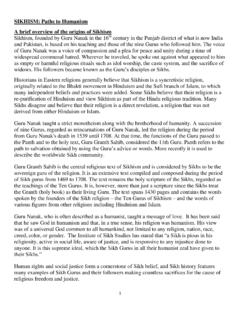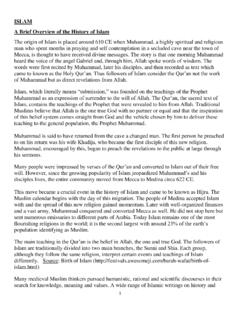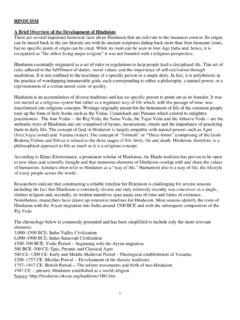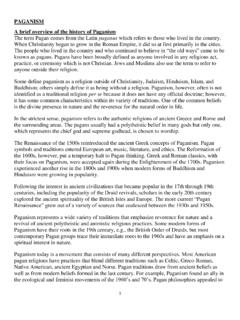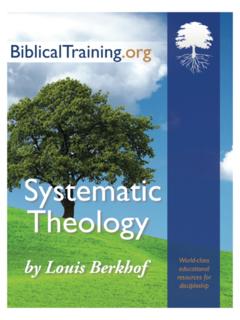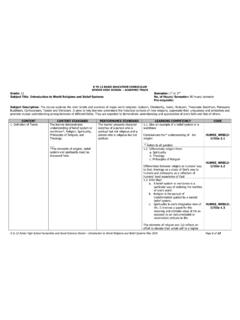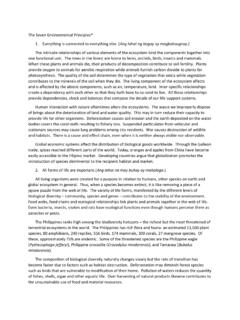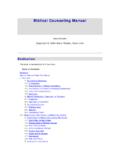Transcription of JUDAISM A Brief Overview of the History of Judaism
1 1 JUDAISM A Brief Overview of the History of JUDAISM In circa 2000 BCE, the God of the ancient Israelites is portrayed in the Hebrew Bible as having established a " covenant " or b'rit with Abraham. Four religious traditions trace their roots back to the Abraham: JUDAISM , Christianity, Islam and, more recently, the Baha'i faith. The book of Genesis describes the events surrounding the lives of the three patriarchs, Abraham, Isaac, and Jacob who, along with other characters in Jewish lore, may not be connected to any historical reality. Moses was mythologized as the next leader of the ancient Israelites.
2 The Bible depicts him leading his people out of captivity in Egypt and receiving from the one true God the revelation at Mt. Sinai of the five books of the Torah "the Law." The story continues with four decades of wandering through the wilderness, and Joshua then leading the tribes into the fertile promised land of the covenant , where the Hebrews were to become a populous nation. According to the biblical narratives, the original multi-tribal alliance was converted into a kingdom by Samuel, with its first king being Saul, followed by David, who established Jerusalem as the religious and political center.
3 While scholars continue to debate evidence for all these characters, after the third king, Solomon was said to have died in 922 BCE, the division into the Northern kingdom of Israel and the Southern kingdom of Judah occurred. Israel fell to Assyria in 722 BCE; Judah fell to the Babylonians in 587 BCE. Alexander the Great invaded the area in 332 BCE. From circa 300 to 63 BCE, Greek became the language of commerce and Greek/Hellenistic culture had a major influence on JUDAISM . And in 63 BCE, the Roman Empire took control of Palestine. Several major religious sects were formed by the 1st century CE including the Essenes, Pharisees and Sadducees.
4 Many anticipated the arrival of the Messiah who would drive out the Roman invaders and restore independence. Christianity was established initially as a Jewish sect centered in Jerusalem when Paul broke with Judaic tradition by spreading the religion to the Gentiles. Jews were now scattered throughout the world in what is known as the Diaspora. Their religion was no longer centered in Jerusalem and Jews were prohibited from setting foot there. The local synagogue became the center of Jewish life as authority shifted from the centralized priesthood to local scholars and teachers, giving rise to Rabbinic JUDAISM .
5 This period gave rise to heavy persecution of the Jews throughout Europe and Russia. Many false stories were spread, accusing Jews of ritual murder, the desecration of the Catholic host, and responsibility for the execution of Jesus. Unsubstantiated rumors continue to be circulated for centuries. As we know, in the 1930s and 1940s, Hitler and the German Nazi party drew on 2 centuries of anti-Semitism and their own warped beliefs in racial purity. The result, as we know, was the Holocaust. The goal of the Zionist movement was the creation, in 1948, of a homeland, the state of Israel.
6 There are currently about 18 million Jews throughout the world. They are mainly concentrated in North America (about 7 million) and Israel (about million). Principles of JUDAISM Attempting to summarize the principles of JUDAISM is like trying to fit a hat on different heads because the forms are widely differentiated. Below is a Brief Overview of the principles in the various branches of JUDAISM : Orthodox, Conservative, Reform, Reconstructionist, Renewal, and Humanistic, from the most traditional and familiar to the most recent and innovative. Orthodox JUDAISM is made up of sub-groups including the modern Orthodox, who have largely integrated into modern society while maintaining observance of Halakhah/Jewish law; the Chasidim who live separately and dress distinctively (commonly, but erroneously, referred to in the media as the ultra-Orthodox ), and the Yeshivish Orthodox, who are neither Chasidic nor modern.
7 The Orthodox movements are similar in belief in that they all believe that God gave Moses the whole Torah at Mount Sinai. The whole Torah includes both the Written Torah (the first five books of the Bible) and the Oral Torah, an oral tradition interpreting and explaining the Written Torah. They believe that the Torah has come down to us intact and unchanged and that it contains 613 commandments binding upon Jews but not upon non-Jews. While there is no one official statement of principles, most of Orthodox JUDAISM observes a particular form of theology based on Maimonides 13 principles of Jewish faith.
8 Maimonides (1135 1204 CE) presented these principles as the fundamental truths of our religion and its very foundations. While we will not list all of them here, the following will indicate the strictly theistic nature of Orthodox JUDAISM : Belief in the existence of the Creator, who is perfect in every manner of existence and is the Primary Cause of all that exists Belief in God's non-corporeality Belief that God communicates with man through prophecy Belief in the divine origin of the Torah Belief in the immutability of the Torah Belief in God's omniscience and providence Belief in divine reward and retribution 3 Conservative JUDAISM is represented by the Leadership Council of Conservative JUDAISM s official statement of beliefs in 1988 which affirmed belief in God and in the divine inspiration of the Torah.
9 However, it also affirmed the legitimacy of multiple interpretations of these matters. The Council presented the following several main beliefs shared by representatives from different parts of the Conservative movement: Affirmation of faith in God as the Creator and Governor of the universe Authority of the Halakhah (Jewish law) Pluralism which has characterized Jewish life and thought through the centuries Centrality of ethics in the life of the Jews Regard for Israel as the Holy Land Jewish law and tradition that enriches Jewish life and that helps mold the world closer to the prophetic vision of the Kingdom of God Other aspects of Conservative JUDAISM include that Jewish law is not static but has developed in response to changing conditions.
10 Jewish law is both still valid and indispensible, although Conservative JUDAISM holds to a more open and flexible view than the Orthodox view of how law has and should develop. Conservative JUDAISM generally accepts the binding nature of Jewish law but believes that the law should adapt, absorbing aspects of the predominant culture while remaining true to JUDAISM s values. Reform JUDAISM s most recent official platform was developed by the Central Conference of American Rabbis in 1999 in A Statement of Principles for Reform JUDAISM . One of the central principles is the autonomy of the individual who had the right to decide whether to subscribe to a particular belief or practice even belief in God, which only a small majority of Reform Jews accept.
